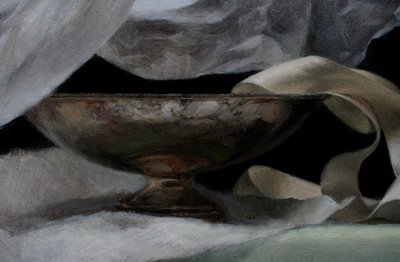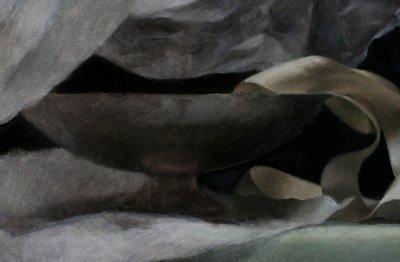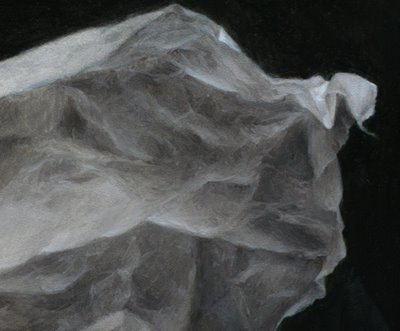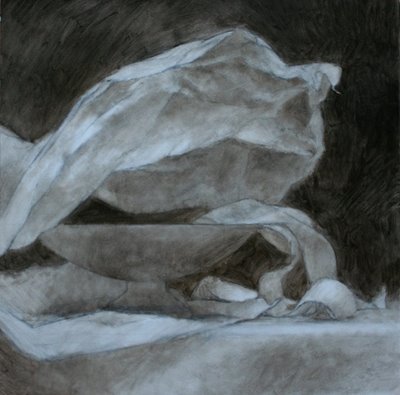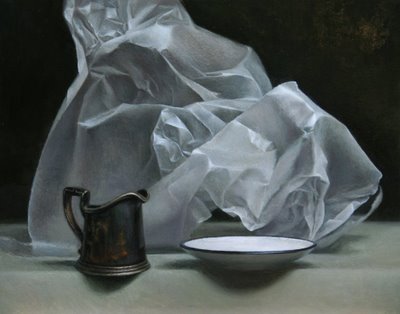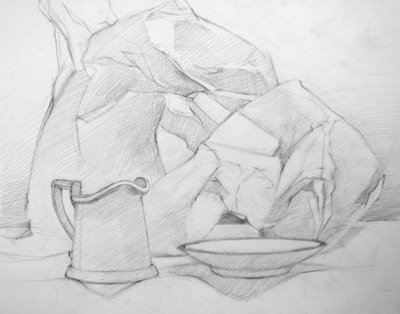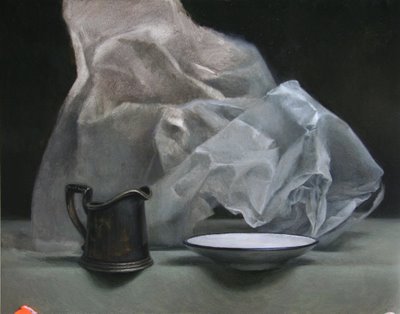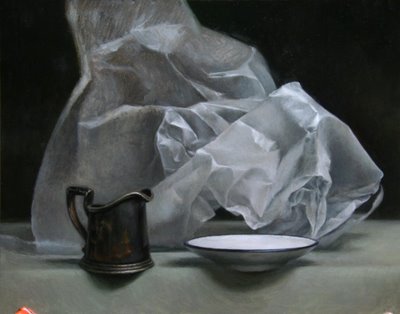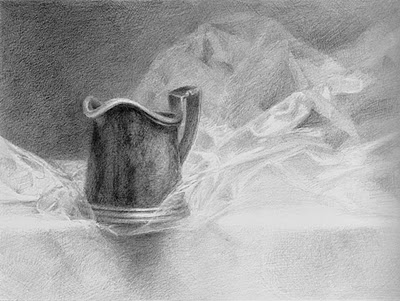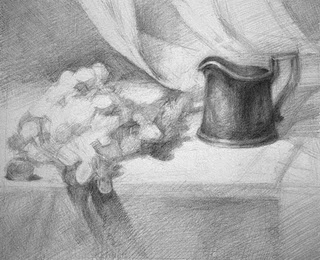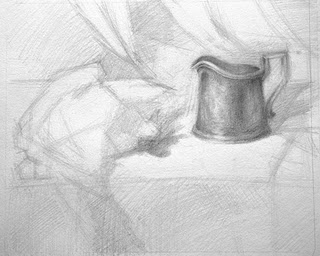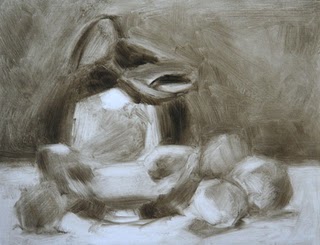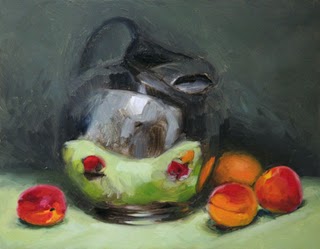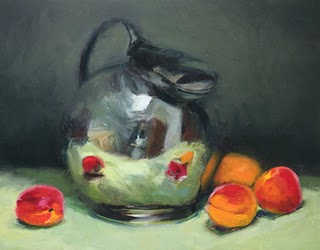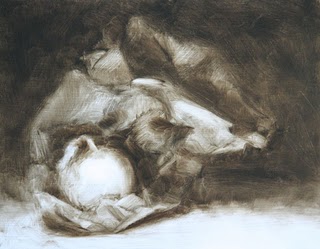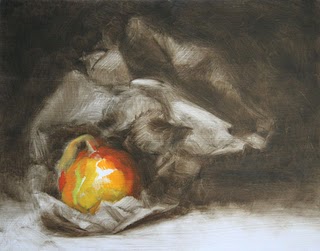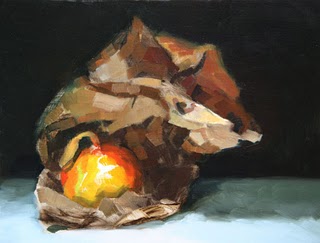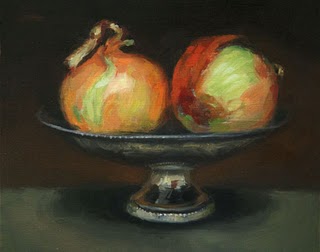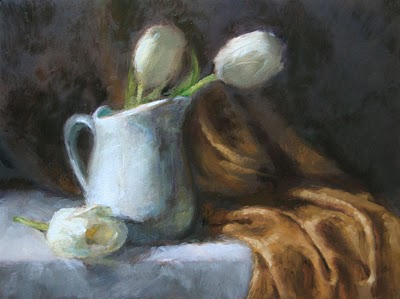 9 x 12, oil on panel
9 x 12, oil on panelAfter my little monochromatic studies last week, I decided to try a larger color painting. I painted this over two days, about 3-4 hours per day. The progression is below:
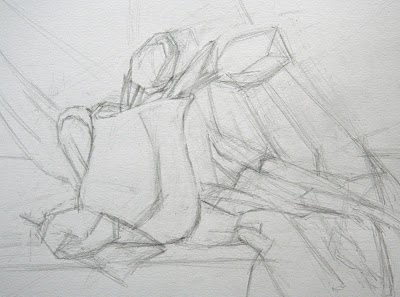 I started with a quick drawing. I spent an hour just doing a basic block-in with pencil on paper, to work out the composition and get the main proportions right. It's tempting to skip this step, but it saves so much time and struggle with the paint later on.
I started with a quick drawing. I spent an hour just doing a basic block-in with pencil on paper, to work out the composition and get the main proportions right. It's tempting to skip this step, but it saves so much time and struggle with the paint later on.
 Next I tranferred the drawing to the panel. I use transfer paper, which is a tissue paper with a thin layer of graphite coating one side. I taped my panel to my table, taped a piece of tranfer over that with the graphite-side down, and then I taped down my drawing over it, pressing the corners to match up the drawing to the panel underneath. Then I traced the major lines of my drawing with a hard pencil.
Next I tranferred the drawing to the panel. I use transfer paper, which is a tissue paper with a thin layer of graphite coating one side. I taped my panel to my table, taped a piece of tranfer over that with the graphite-side down, and then I taped down my drawing over it, pressing the corners to match up the drawing to the panel underneath. Then I traced the major lines of my drawing with a hard pencil.
 After I transferred my drawing, I went over the faint graphite lines on the panel with a brown extra-fine sharpie. Some people use a quill pen and sepia ink. That's too much work for me, but I would like to find a lighter-colored sharpie.
After I transferred my drawing, I went over the faint graphite lines on the panel with a brown extra-fine sharpie. Some people use a quill pen and sepia ink. That's too much work for me, but I would like to find a lighter-colored sharpie.
 This is my drawing taped below my panel. The drawing has a lot more detail, so I ended up taping it off to the right so I could see it while I worked on the underpainting.
This is my drawing taped below my panel. The drawing has a lot more detail, so I ended up taping it off to the right so I could see it while I worked on the underpainting.
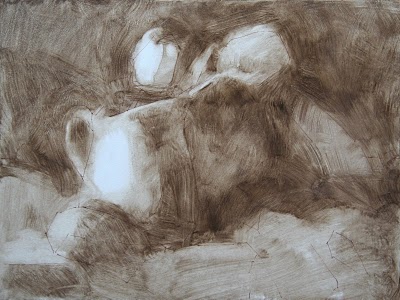 This is the start of the underpainting using the wipeout method. I used mainly raw umber, with a little ultramarine blue and a little white mixed in. I used a Viva paper towel as a rag to wipe out the white areas. I love Viva paper towels, they are the best for painting - almost as strong as cloth and not many fibers.
This is the start of the underpainting using the wipeout method. I used mainly raw umber, with a little ultramarine blue and a little white mixed in. I used a Viva paper towel as a rag to wipe out the white areas. I love Viva paper towels, they are the best for painting - almost as strong as cloth and not many fibers.
 More refined stage of the underpainting.
More refined stage of the underpainting.
 I started adding color. At this point I left the painting for another day.
I started adding color. At this point I left the painting for another day.
 The second day I just worked at refining my colors and getting more detail. The overall look at this stage was very impressionistic. I was trying not to blend very much, keep the brushtrokes visible. I tried to work from dark areas to light areas, mixing a lot of color into the midtones.
The second day I just worked at refining my colors and getting more detail. The overall look at this stage was very impressionistic. I was trying not to blend very much, keep the brushtrokes visible. I tried to work from dark areas to light areas, mixing a lot of color into the midtones.
 The final painting. I'd like to do just a drapery study sometime, it was really fun. The tulips were ideal flowers because they last a long time and don't change much over a few days. They stayed fresh because my studio is very cold. But as I worked with my space heater turned on, the flowers warmed up and opened. I have no idea how people paint flowers in detail... even stable ones like tulips move too much.
The final painting. I'd like to do just a drapery study sometime, it was really fun. The tulips were ideal flowers because they last a long time and don't change much over a few days. They stayed fresh because my studio is very cold. But as I worked with my space heater turned on, the flowers warmed up and opened. I have no idea how people paint flowers in detail... even stable ones like tulips move too much.
Finally, here's a picture of my current studio setup:
 The large white panel at the top is a piece of foamcore I have hung from the ceiling, to block my still life setup from the skylight. The light from the skylight falls on my easel, but not on the still life.
The large white panel at the top is a piece of foamcore I have hung from the ceiling, to block my still life setup from the skylight. The light from the skylight falls on my easel, but not on the still life.
I've lit the still life with my white light "daylight" lamp from the left side. I also tried clamping my palette to my easel, as you can see. I abandoned that after 1 day though, it was annoying. But I hate having one hand occupied holding my palette all the time.
One day I will find the perfect clamp that will hold my palette right where I want it....
 Friday, August 29, 2008 at 2:12AM
Friday, August 29, 2008 at 2:12AM 
